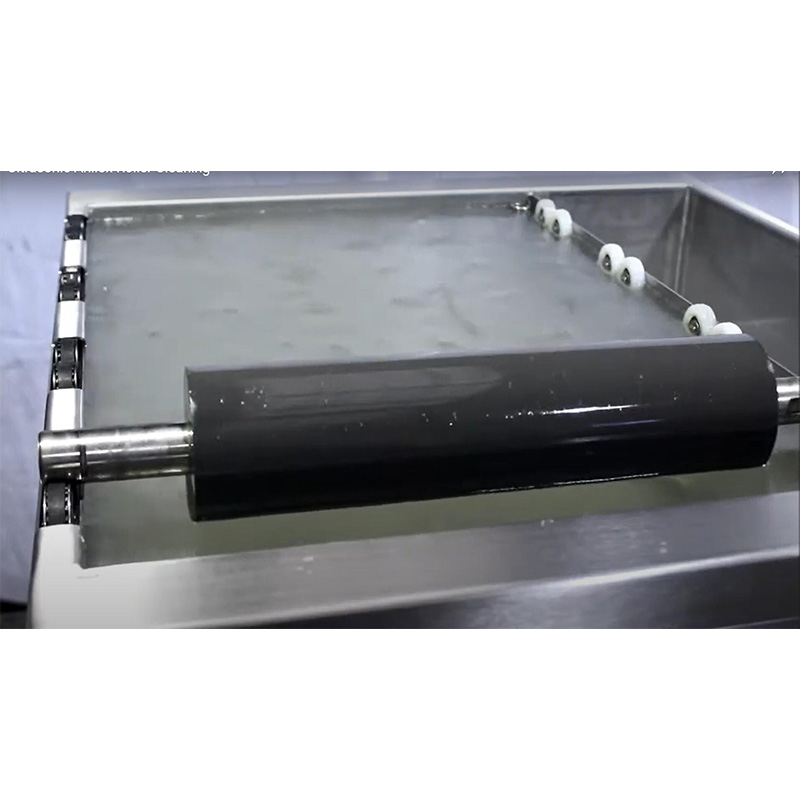COMPANY NEWS
Advantages of Ultrasonic Cleaning for Anilox Rollers
Among various methods for cleaning anilox rollers, ultrasonic cleaning stands out as one of the most advanced techniques, based on firsthand information gathered through extensive practical experience. In comparison to other cleaning methods, ultrasonic cleaning offers several distinctive advantages:

1. Expertise in Cleaning Micro-Pores:
Anilox rollers, whether made of metal or ceramic, feature tiny pores used to store ink. Taking a standard 600 LPI anilox roller as an example, with pore diameters around 30 micrometers, conventional cleaning tools struggle to access and clean these fine pores. In contrast, ultrasonic cleaning generates bubbles with diameters of 2 to 5 micrometers, allowing 6 to 15 bubbles to simultaneously enter a single pore and physically impact the debris at the bottom. This unparalleled precision achieves thorough and effective cleaning, surpassing other methods.
2. Thorough Cleaning Effect:
Ultrasonic cleaning relies on the principle of ultrasonic transducer-generated bubbles surrounding the anilox roller. These bubbles, invisible to the naked eye, uniformly and densely envelop the roller, dislodging contaminants on both flat and recessed surfaces. The cleaning solution activates and reduces the adhesion of impurities inside the pores, making them easily detachable under the influence of the bubbles. This combination of physical and chemical actions ensures a comprehensive and efficient cleaning process.
3. Integration of Physical and Chemical Actions:
The bubbles produced by ultrasonic waves physically dislodge impurities, constituting a physical action. Simultaneously, the cleaning solution chemically reduces the adhesive forces of contaminants, representing a chemical action. The synergy of these physical and chemical principles results in a more thorough and rational cleaning process, a unique advantage not found in other cleaning methods.
4. Minimal Risk of Damaging the Object:
Microscopic bubbles generated by ultrasonic waves enter the anilox roller's pores and exert limited physical force on the cleaned object. The impact force is controlled by the generator's power and frequency, tailored to the specific cleaning requirements of different objects. This gentle impact poses minimal risk to the anilox roller, contrasting with the potential damage caused by purely physical or strong acid and alkali cleaning methods.
5. Convenient Operation and Environmentally Friendly:
Ultrasonic cleaning transforms electrical energy into kinetic energy, representing an environmentally friendly method with no dust dispersion or wastewater runoff. The sole consumable is the cleaning solution, aiding in enhancing impurity activity for easy detachment under the influence of bubbles. The cleaning process is straightforward—simply place the anilox roller into the cleaning solution-filled tank and press the cleaning switch. Choosing an environmentally friendly cleaning solution allows for direct discharge into the drainage system.
6. Points to Note:
The essence of ultrasonic cleaning is not vibration but a byproduct of transducer-generated vibrations. Objects with higher density may experience resonance effects, potentially enlarging existing cracks or fissures in brittle materials like ceramic anilox rollers. Therefore, a careful inspection of ceramic rollers for any damage before cleaning is essential. Ceramic anilox rollers with pre-existing cracks are already damaged, and using them with any cleaning method may exacerbate their condition.
7. Clarification Needed:
While various other cleaning methods exist, such as caustic soda (strong alkali) heating cleaning and high-pressure air sandblasting (sodium bicarbonate powder) direct jet cleaning, ultrasonic cleaning is currently considered safer and more effective. A brief comparison of the three methods:
- Caustic soda heating cleaning relies solely on chemical action, with the drawback of low cost but a high risk of corrosion, especially for metal rollers. Despite ceramic rollers having some resistance to strong alkalis, heating can cause the outer ceramic layer to crack.
- High-pressure air sandblasting directly impacts the surface of anilox rollers with uneven sand or powder particles, making it challenging to clean high-line count rollers thoroughly. Prolonged use of high-pressure blasting may lead to the collapse of the roller's mesh walls.
- Ultrasonic cleaning combines both chemical and physical actions, allowing fine bubbles to penetrate the pores of high-line count anilox rollers easily. The use of a neutral or weakly alkaline cleaning solution ensures minimal damage, making it a superior choice for cleaning anilox rollers.
In conclusion, while no cleaning method can completely avoid damage to anilox rollers, choosing the appropriate cleaning technique is crucial for protecting and extending the roller's lifespan."

